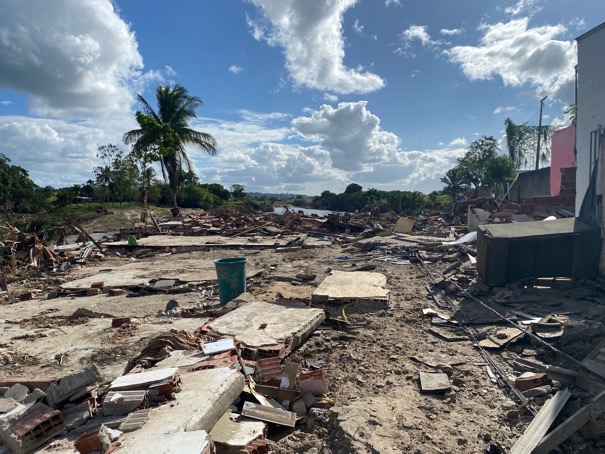Floods in Bahia Province 🇧🇷

Itabuna, Brazil, January 2022
In January 2022, right after my mission in Argentina, I barely had time to repack in Panama City before heading straight to Brazil. This trip was not for leisure—it was to support Caritas in responding to the devastating floods that had hit Bahia.
The Floods in Bahia – Unprecedented Destruction
The flooding in Bahia was one of the worst natural disasters to hit the region in decades. Torrential rains caused rivers to overflow, entire towns to be submerged, and thousands of families to lose everything. Roads and bridges were washed away, leaving many communities isolated and unreachable. The level of destruction was overwhelming—some areas were completely wiped out, homes and livelihoods gone in an instant.
Caritas, along with other humanitarian organisations, worked tirelessly to assist those affected, providing:
• Emergency shelter for displaced families
• Food and hygiene kits
• Psychosocial support for traumatised communities
• Reconstruction efforts to help people rebuild their homes
Despite the challenges of accessing remote areas, I saw firsthand Caritas’ incredible dedication and service to those in need. Their work was truly inspiring.
A Quick Stop in Salvador – A Glimpse of Afro-Brazilian Culture
While transferring in Salvador, I had an unexpected free afternoon, which gave me the chance to explore the city’s historic centre.
Salvador is the heart of Afro-Brazilian culture, with its colonial-era architecture, vibrant music, and deep-rooted traditions. Walking through the Pelourinho district, with its colourful buildings, cobbled streets, and rhythmic beats of samba and capoeira, was an unforgettable experience. Even though my time there was short, I could feel the spirit and soul of the city.
Travelling Through the Flooded Regions
After Salvador, I travelled to some of the hardest-hit areas:
• Ilhéus – Known for its stunning coastline, now dealing with the reality of flood damage.
• Banco de Vitória, Itajuípe, and Itabuna – Areas where entire neighbourhoods were underwater, and families were trying to salvage what little they had left.
• Teixeira de Freitas, Medeiros Neto, and Itamaraju – Towns where relief efforts were in full force, yet rebuilding would take years.
The resilience of the people I met was remarkable. Despite losing so much, they remained hopeful, determined, and grateful for any help they received.
A Sweet Surprise – Visiting a Chocolate Plantation in Itabuna
While in Itabuna, completely by chance, I had the opportunity to visit a chocolate plantation, which turned out to be one of the most fascinating experiences of the trip.
The Bahia region has a long history of cacao production, making it one of Brazil’s most important areas for chocolate cultivation. The plantation visit gave me insight into the entire chocolate-making process, from harvesting the cacao pods to fermentation, drying, and finally transforming the beans into chocolate.
For decades, cacao farming was one of Bahia’s biggest industries, but in the late 20th century, a disease called “witch’s broom” (vassoura-de-bruxa) devastated cacao trees, nearly collapsing the industry. Today, through sustainable farming practices and local innovation, Bahia is making a comeback in high-quality chocolate production.
It was eye-opening to see the effort and craftsmanship that goes into something as simple as a chocolate bar, making me appreciate it even more!
Reflections on the Mission
This trip to Brazil was a mix of tragedy and resilience. The floods left behind unimaginable destruction, yet the strength of communities, the dedication of humanitarian workers, and even small moments of discovery—like the chocolate plantation visit—made this journey unforgettable.
Caritas’ efforts, the spirit of the affected families, and the resilience of Bahia’s people were a powerful reminder that even in the face of disaster, hope and humanity prevail.
Click here to access the album.
